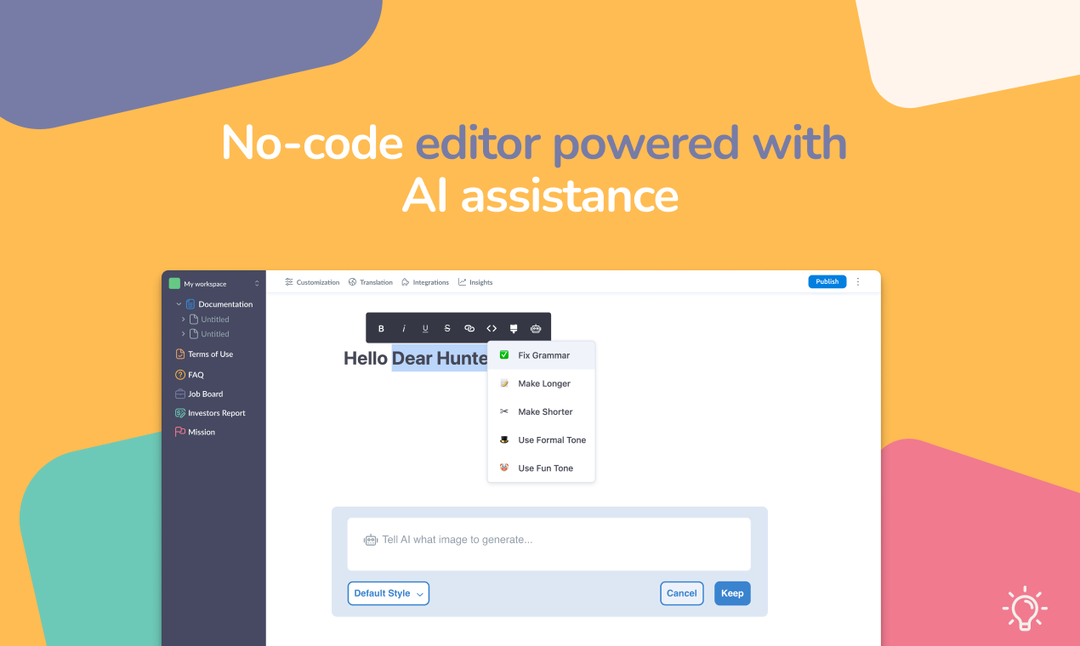How could we resist?
New things tend to offer endless opportunities, so we wanted to see what we could get. When we took this step, other companies had already taken it, but we had more potential. For us, it has always been keen to be able to deploy our content everywhere, and now we could also use AI to create text that would still sound like natural language! When giving a prompt, it would generate text that would continue the prompt. The possibilities from here on had no limits.
Notion was already using GTP3/DALL-E, but their solution only allows you to host inside Notion itself. With Notice, you could create your own content and automatically add it to your Notice blocks. This means you could move forward even before having writer's block! Our bet was on efficiency and speed going beyond automation.

How did we go about integrating OpenAI?
We started a new raw project and then started experimenting. By then, it was a very simple API, barely more than the roots of something bigger. We created small services that were able to build a bridge between our application and OpenAI. So, our product called OpenAI's API. Hundreds of prompts were tested until we eventually found the right one.
The problem was that, with updates, this broke. We had to create new prompts, and still look out for changes. This is one of the struggles of generative AI.
Most of the problems did not come from Notice. For example, moderation: we needed to filter the things that were sent to OpenAI, because one bad user could get our entire service banned from the platform. We also had to deal with server crashes from OpenAI's server side. Occasionally, they would be down for half a day, and our app would crash because of that!
At the end of the day, it was a process. That’s the appeal and, sometimes, the difficulty of cutting-edge tech. You have to take risks, be ready to deal with the unexpected and embrace just a little bit of chaos.
But we had a plan. And we were moving forward.
API Keys VS Credit System: our pick
A lot of our competitors are using API keys, but we knew we wanted to use a credit system. We didn’t want the user to ever have to add their own API keys. There were many reasons why we decided not to implement a separate API. For example, we did not want to put security at risk, since this is the main concern in these regards. Also, we knew the users would be sensitive to paying more. Besides, AI is a huge value-add for our users, so we wanted to use an integrated system that would not limit our upgrade potential.
The most challenging step
Can you guess what it was?
Monetization.
It’s a big challenge. Even if we have an error with the API on our side, we are spending tokens. It goes without saying that we had to find a solution to stop users from finding our API token, to prevent it from being exploited, and in order to make this happen we created a separate account. Since our goal is to clarify the user experience, we fully intend to switch to an unlimited format for NoticeAI, without tokens. Of course, to do so, we need to find a secure and stable solution.
The good news? Connecting with OpenAI is very easy. In the future, we want to do a stream, so the progress of the AI can be seen in real-time. The user will be able to cancel it, keep it, or just start again. We want to do this so it improves the experience. We don't want users to lose their content or wait too long for an answer.
Conclusions
AI is here to help us. By integrating GTP3/DALL-E, we aim to help people write faster and better. You now have in-line access to AI to produce text that sounds like you wrote it, so there's no need to struggle with finding the right words or structures. That's what will help us to speed up writing around the world! This is not only a major improvement for non-native speakers, but also a goodbye to writer's block!
So, efficiency is a priority, and so are speed and quality. Want to give Notice a go, and for free? Then, please just follow this link.



